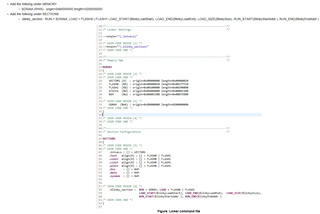Other Parts Discussed in Thread: TMS570LC4357,
Dear TI Team,
1. I am try to execute code from SDRAM by changing the Linker script file as suggest in below thread.
my current modified script file is as follows:
/*****************************************************************************/
/* Suppress warnings and errors: */
/* #10199-D CRC table operator (crc_table_for_<>) ignored:
CRC table operator cannot be associated with empty output section */
--diag_suppress=10199
--retain=interruptVectors
#define APP_BASE 0x60000000
#define RAM_BASE 0x60100000
MEMORY
{
FLASH (RX) : origin = APP_BASE, length = 0x00100000
SRAM (RWX) : origin = RAM_BASE, length = 0x00040000
}
/* The following command line options are set as part of the CCS project. */
/* If you are building using the command line, or for some reason want to */
/* define them here, you can uncomment and modify these lines as needed. */
/* If you are using CCS for building, it is probably better to make any such */
/* modifications in your CCS project and leave this file alone. */
/* */
/* --heap_size=0 */
/* --stack_size=256 */
/* --library=rtsv7M4_T_le_eabi.lib */
/* Section allocation in memory */
SECTIONS
{
#ifndef gen_crc_table
.intvecs: > APP_BASE
.text : > FLASH
.const : > FLASH
.cinit : > FLASH
.pinit : > FLASH
.rodata : > FLASH
.init_array : > FLASH
#else
.intvecs: > 0x00000000, crc_table(crc_table_for_intvecs)
.text : > FLASH, crc_table(crc_table_for_text)
.const : > FLASH, crc_table(crc_table_for_const)
.cinit : > FLASH, crc_table(crc_table_for_cinit)
.pinit : > FLASH, crc_table(crc_table_for_pinit)
.rodata : > FLASH, crc_table(crc_table_for_pinit)
.init_array : > FLASH, crc_table(crc_table_for_init_array)
.TI.crctab : > FLASH
#endif
.vtable : > RAM_BASE
.data : > SRAM
.bss : > SRAM
.sysmem : > SRAM
.stack : > SRAM
}
__STACK_TOP = __stack + 512;
/****************************************************************************************/
1. After copying .out file data into SDRAM i am calling below function.
/****************************************************************************************/
UINT32 entryPiont;
entryPiont = 0x60000000; //SDRAM memory Address
appEntry = (void (*)(void))entryPiont;
(*appEntry)();
/**************************************************************************************/
2. The code is not executing from SDRAM as expected.
3. is there any modification need to be done in linker script or above function ?
Regards,
Naga Narasimha Rao P




